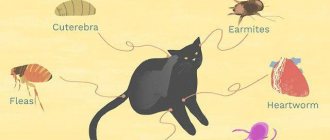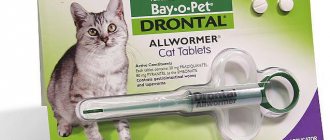What will you learn from the article?
- Where does a cat get worms?
- Symptoms
- Types of worms Tapeworms (cestodes)
- Roundworms (nematodes)
- Flukes (trematodes)
- Medicines for helminths
Helminths (worms in cats) are a very common parasitic disease that can pose a serious threat to the health and life of a pet. From this article you will learn what to do in case of helminthiasis, how to deworm (what anthelmintic drugs to give) and, most importantly, how to prevent your cat from becoming infected with parasites.
Where does a cat get worms?
Worm larvae and adult parasites are found in the environment: in the soil, on the grass, in water bodies. Therefore, it does not mean at all that if your cat is an indoor cat and does not go outside, then he cannot become infected with worms. You yourself can bring the larvae on the soles of your shoes or on your clothes.
Other sources of infection:
- when your cat eats raw fish, meat, or tap water;
- when fleas appear, there is a possibility of your pet becoming infected with worms;
- upon contact with sick animals, contaminated objects (sand, soil) and feces;
- Intrauterine infection of kittens from a pregnant cat is possible.
What is the harm from worms?
A pet infected with worms is a danger to all family members. Worm eggs are transmitted to people through unwashed hands before eating or frequent kissing of your pet.
Parasites have a detrimental effect on a cat's body. The longer they are present in it, the more weakened the pet is:
- Immunity decreases;
- Feeling worse;
The animal experiences pain and spasms;
- Lethargy and loss of interest in others.
Worms pose a serious danger to kittens. A fragile body cannot cope with their destructive effect. A large number of helminths in a kitten’s body can lead to its death.
Symptoms
- The presence of fleas is a direct sign of the appearance of worms in a cat.
- Invasive parasites can live not only in the intestines, but also in the bronchi, muscles, and liver, so a number of symptoms may be observed indicating the presence of helminths:
- general exhaustion of the body;
- dull coat;
- lethargic state of the pet;
- refusal of food or, conversely, increased appetite;
- thirst;
- weight loss;
- vomiting and diarrhea (the presence of parasites can be seen in vomit or feces).
- Small rashes around the anus.
- Kittens have swollen bellies, very pale mucous membranes (due to anemia), an upset stomach is replaced by constipation, bloody diarrhea.
Why is it important
When vaccinated, weakened pathogens of various infections are introduced into the cat’s body. They cannot cause disease, but contain antigens. In response, the immune system produces antibodies - special active substances that help destroy “uninvited guests”.
Helminths take away some of the nutrients, causing the cat to experience a deficiency of vitamins and minerals. In the process of parasitism, the functioning of internal organs is also disrupted, the immune system is weakened, and its protective functions are reduced, which facilitates the penetration of pathogenic microorganisms into the animal’s body. As a result, the immune system cannot provide a full response to vaccine antigens. In addition, if there are two enemies in the body - worms and viruses - the immune system has to fight on 2 fronts, which turns out to be quite difficult for it. As a result, vaccination may be useless: immunity to the vaccine will not develop, and the cat will get sick the first time it encounters the virus. This situation is called “breakthrough of post-vaccination immunity.”
It is especially important to eliminate parasites before rabies vaccination. This vaccination requires an adequate immune response to provide full protection. If the immune system is not strong enough, the cat may become infected with a fatal infection.
Types of worms
The following types of worms parasitize cats. Each type has its own symptoms and routes of infection.
Tapeworms (cestodes)
Long and flatworms can reach a length of up to 70 cm. The body of these worms consists of many segments, in each of which larvae mature.
When the larvae mature, they separate and come out together with the feces, while the segmented body of the parasite grows continuously, and new segments with larvae appear to replace the separated segments.
Routes of infection
Cats become infected with this type of worms by eating raw meat and fish. Stray animals often become infected with cestodes by eating rats or mice. Infection through larval carriers, fleas, is also possible. Helminths parasitize the walls of the cat's small intestine.
Signs of tapeworm infestation:
- changes in the pet’s body weight (the weight either increases sharply, or the cat, on the contrary, rapidly loses weight);
- change in appetite (the cat is insatiable or, on the contrary, refuses food);
- large, “inflated” belly;
- hair loss;
- Excessive licking in the anal area.
Why are they dangerous?
The cat's gastrointestinal tract becomes clogged with worms, causing intestinal obstruction. Possible death.
As you can see
It is very common to see tapeworm segments around the anus of a sick animal - these segments resemble grains of rice or sesame. Also, individual parts of cestodes are found on the animal’s bedding. In a more severe form of worm infestation, parasites can be seen in the vomit.
Roundworms (nematodes)
The most common type of internal parasites that infect cats. There are many varieties, but the most common in our pets are roundworms. In appearance, the parasites resemble spaghetti, which is where the name “round” comes from. The length of roundworms usually reaches 5 cm, but longer individuals are also found.
Routes of infection
Kittens can become infected with roundworms through their mother's milk. The danger of infection lies in wait for an adult cat when eating rodents, raw meat and in contact with an infected animal.
Signs of roundworm infection:
- weight loss;
- enlarged belly;
- vomit;
- diarrhea;
- general weakness.
Why are they dangerous?
Worms accumulate in the small intestine, injure the gastric mucosa, and can clog the bile ducts and intestines. They can parasitize almost all organs of the animal, having a strong toxic and allergic effect on the body.
As you can see
With intense helminthic infestation, nematodes can be seen in sputum after coughing or in vomit. Roundworm eggs can accumulate in the folds around the animal's anus.
Flukes (trematodes)
Parasites that can be localized anywhere: in the gastrointestinal tract, liver, bile ducts, respiratory organs. These are flatworms with suckers, with which they are firmly attached to the tissues of internal organs, most often the liver. With these suckers, hermaphrodite worms attach to the tissues of the cat's internal organs, eating and destroying them.
Routes of infection
Infection occurs by eating raw fish, seafood or through raw water.
Symptoms of fluke infection:
- cough;
- dyspnea;
- jaundice;
- vomit;
- weight loss;
- diarrhea;
- painful stomach;
- depressed state.
Why are they dangerous?
The activity of parasites disrupts the patency of the bile ducts, causing cirrhosis and liver failure. This can cause lethargy and death.
As you can see
The moving parts of the flukes can come out through the cat's anus. If you look closely, you can see tiny translucent parts of the parasite around the animal's anus, on its bedding.
Complications after deworming a cat
Deworming can only be harmful if the procedure is performed incorrectly or the medications are not suitable for the cat. As a result, complications may appear:
- sudden weight loss;
- severe diarrhea, vomiting;
- dyspnea;
- problems with stool (up to intestinal failure);
- allergic reactions, anaphylactic shock;
- bleeding in the gastrointestinal tract;
- congenital defects in the next generation of kittens;
- sudden changes in blood pressure;
- breathing problems (even stopping);
- kidney dysfunction;
- foaming at the mouth.
If worming is missed according to schedule and the degree of parasite infestation is high, this will lead to the death of the pet. A fatal outcome can also occur in a cat that is severely weakened by the disease and suffers from multiple organ failure. Sometimes it is impossible to save a cat even in a hospital setting.
Cats need to be dewormed (dewormed) regularly, even for pets. A timely and correctly performed procedure will help protect the cat from the appearance of parasites, intoxication of the body, dysfunction of internal organs, and sometimes even save its life.
Diagnostics
A final diagnosis can only be made by a veterinarian after studying the anamnesis and taking the animal’s feces and blood for analysis. A stool sample is collected for three consecutive days to rule out a “false negative diagnosis.”
If the owner notices particles of worms in the cat’s feces or on the animal’s body, then this should also be reported to the veterinarian.
Important!
Please note that parasite larvae may persist in the milk of nursing cats. Therefore, even if the mother cat has a negative test for worms, it is necessary to carry out thorough anthelmintic therapy for the babies.
Prevention of worms: how often to give tablets and precautions
The highest quality care, feeding, keeping it clean and any of your efforts will not protect your pet from helminthic infestation. Even if the cat does not go outside, it becomes a victim of parasites by coming into contact with your things, products, etc.
It is also worth understanding that some types of worms are common to cats and humans.
- The only salvation from “uninvited neighbors” is regular prevention.
- How often should prophylactic medications be given? According to generally accepted standards, prevention of worms in pets is carried out once every three to four months. Due to the peculiarities of the life cycle of parasites, their active reproduction occurs in February-March and September-October.
Note! If you have several pets, anthelmintic measures should be carried out simultaneously for all four-legged animals.
Is it possible to give deworming tablets to a pregnant or lactating cat?
For the safety of the expectant mother and her offspring, all preventive measures, including vaccination, are carried out before mating. Not only the cat, but also the cat should undergo treatment for parasites. In addition, both parents should be examined for viral and infectious diseases.
If for some reason prevention of worms was not carried out before mating, taking preventive medications is associated with risks. Any preventive measures are carried out for a pregnant cat after the second half of pregnancy. If this deadline has been missed, you must wait for delivery.
Note! The safest period for carrying out emergency preventive measures is considered to be the period from the fourth to the sixth week of pregnancy.
Some types of parasites can travel throughout the body. Worm eggs are absorbed into the bloodstream, and from there they can enter any organ and milk. If a pregnant cat has not received worm prevention, the offspring may die from parasites, the eggs of which they receive in their mother's milk. There are also parasites whose eggs are able to penetrate the placental barrier.
Note! It is strictly not recommended to prevent worms in a nursing cat.
If the veterinarian is sure that the cat is infected with parasites that can threaten the lives of the kittens, proceed as follows:
- Kittens are taken away from their mother and placed on artificial nutrition.
- The cat is fed intensively for several days.
- The cat is being treated for worms.
- Depending on the drug, a period of time is “held” during which all toxins are eliminated from the body.
- Afterwards, if possible, the kittens are returned to their mother.
Note! Kittens, before four weeks of age, should absolutely not be given standard deworming medications.
There are only a few drugs that act mildly and are used in cases of obvious invasion that threatens life.
Antihelminthics for cats
Anthelmintic drugs are prescribed for medicinal purposes by a veterinarian after all tests have been carried out, the type of parasites, the location and degree of helminthic infestation have been determined.
The doctor must select the brand and form of a targeted drug that acts on a specific type of worm. Or prescribe a medicine with complex action if the cat is infected with several types of helminths or the type of worms could not be determined.
For the purpose of prevention, anthelmintic drugs for cats are prescribed 2-4 times a year. It is mandatory to carry out antiparasitic treatment before mating, before vaccinations and simultaneously with anti-flea drugs.
Medicines for helminths
In veterinary pharmacies, anti-worming drugs for cats with targeted and complex action are widely available in various forms of release:
- Drops on the withers are the most popular products, characterized by quick action and ease of application. The drops are applied to the withers and between the animal's shoulder blades - there is no need to force the cat to drink the bitter medicine.
- Profender (Bayer) - price in Russia for 1 pipette 350-450 rubles / in Ukraine 110-230 UAH);
- Dironet Spot-on (Agrovetzaschita) – price in Russia 350 rubles / in Ukraine 160 UAH.
- Stronghold (Pfizer) – price in Russia 1150 rub. / in Ukraine 550 UAH.
- Anti-worm tablets - given to the animal along with food or “in its pure form”. Preparations with high effectiveness of a complex and targeted (for one type of worm) remedy. Individual selection is possible taking into account the type of parasites, the degree of infestation and the condition of the cat.
- Kanikvantel plus - price in Russia 195 rubles / in Ukraine 70 UAH;
- Enwire - price in Russia 165 rubles / in Ukraine 78 UAH;
- Drontal (Bayer) – price in Russia 320 rubles / in Ukraine 179 UAH;
- Milbemax – price in Russia 330 rubles / in Ukraine 145 UAH;
- Pratel - price in Russia 38 rubles / in Ukraine 6 UAH;
- Trontsil - price in Russia 215 rubles / in Ukraine 15 UAH;
- Febtal – price in Russia 150 rub. / in Ukraine 71 UAH.
- Suspensions or pastes are given to the animal orally using a dispensing syringe. It is convenient to dose and give to cats that refuse to eat tablets.
- Prazicide for adult cats - price in Russia 108 rubles / in Ukraine 45 UAH;
- Prazicide sweet suspension for kittens - price in Russia 127 rubles / in Ukraine 38 UAH.
- Sugar cubes - given to the animal as a treat, with food, or dissolved in water and fed to the animal through a syringe. Animals willingly eat the medicine.
- Polyvercan - price in Russia 605 rub. / in Ukraine 310 UAH.
How to use an anthelmintic drug correctly
- modern drugs for preventive purposes are given once in the morning, a preliminary fasting diet is not required;
- when treating worms in a cat, the drug must be given again after 10-14 days;
- before each vaccination, it is necessary to give antihelminthic drugs 10-15 days before the expected date of vaccination;
- you also need to give antihelminthic drugs 3 weeks before childbirth and 3 weeks after;
How to deworm kittens
- It is not recommended to give anthelmintic drugs to kittens younger than 8 weeks;
- kittens are dewormed for the first time at the age of 2 months, when the body is stronger and can perceive the toxic substances of anthelmintic drugs;
- the drug is chosen on the recommendation of a veterinarian, the dosage is calculated based on the age and weight of the kitten;
- repeat the procedure 10-14 days after the first dose.
Folk remedies
Traditional medicine for worms in cats does not have proven effectiveness and is presented in the article for informational purposes.
- Give a decoction of chamomile or fennel to drink instead of water.
- Cut the onions into 4 parts and pour a glass of warm boiled water. Give your cat this water to drink in the morning on an empty stomach for 7 days.
- Common tansy. Pour 1 tablespoon of flowers with a glass of boiling water and leave for 1 hour, then strain. Give the cat this infusion 2-3 times a day, then feed it no earlier than 30-60 minutes later.
- Alcohol tincture of wormwood is used 10 drops 2 times a day. Feed the cat no earlier than every 30-60 minutes.
- Carrot juice enemas (20 ml) once a day for a week.
The best anti-helminth remedies
Modern veterinary pharmacology offers a fairly wide range of anthelmintic drugs. They differ from each other in their focus on a specific type of worm, in the method of influencing them, in the form of release.
The action of anthelmintic drugs is as follows:
- they have a detrimental effect on the nervous system of worms;
- have a paralyzing effect;
- slow down and stop metabolic processes in the body of the worm;
- literally “dissolve” helminths.
We offer the top 10 most effective and proven drugs for worming domestic cats.
| Name | Spectrum of action | Release form | pros | Minuses |
| Albendazole | Against liver flukes | Powder, tablets | High efficiency | Precise dosage required. Toxic |
| Dirofen | Destroys tapeworms and roundworms | Suspension | Quick effect, few contraindications | |
| Drontal | Target – round and tapeworms | Pills | Allowed for pregnant cats and kittens. No adverse reactions Can be used as a prophylactic agent | |
| Kanikvatel Plus | Against round and tapeworms | Pills | Acts quickly, effectively, and is gentle on the cat’s body | |
| Pirantel | Destroys hook and tapeworms | Pills. Suspension | Can be used by pregnant and lactating cats | Side effects: lack of appetite, vomiting, diarrhea |
| Piperazine | Effective against roundworms, hookworms | Powder. Pills | Quickly eliminated from the body | Narrowly targeted action |
| Poliverkan | Wide spectrum of action. Effective against nematodes and cestodes | Soluble tablets | Allowed for kittens from 1 month | Prohibited for pregnant cats |
| Prazitel | Wide spectrum of action | Pills. Suspension | Safe for kittens, pregnant and lactating cats | Low efficiency |
| Prazicide Plus | Kills flatworms and nematodes | Suspension. Pills | One application is enough | May cause intolerance |
| Profender | Wide spectrum of action | Drops on the withers | Convenient to use. High efficiency | High price |
Pharmacologists are developing more and more new drugs against worms with a wide spectrum of action - low toxic and safe for the animal. The table provided will help the amateur navigate a large number of offers, but in no case does it imply an independent selection of the drug.
There is an opinion that folk remedies - herbal decoctions, crushed seeds - are better than pharmacological drugs. This is not true: herbs can be just as dangerous and toxic.
When treated with traditional methods, it is more difficult to maintain the dosage. This path is much longer and requires more time and effort, which does not always lead to the desired result.
Expert opinion
Chepa Natalya Semenovna
Veterinarian
Ask an expert
I would like to add two more drugs to the list of antiparasitic agents recommended for deworming. The first, Milbemax (beef-flavored tablets), is prescribed for the treatment and prevention of cestodiasis and nematodes (dipylidiasis, toxocariasis, dirofilariasis, etc.). Available in two forms: for kittens and small cats and for large cats. The second drug is Stronghold drops on the withers. Stronghold acts against intestinal roundworms, dirofilariasis and external parasites (fleas, ear and scabies mites, lice). Please note that the drug is not used for the prevention and treatment of helminthiasis caused by tapeworms. Available in three forms: for kittens weighing up to 2.5 kg, for cats weighing 2.6 - 7.5 and over 7.5. Both drugs are used by animals from 6 weeks of age and are approved for pregnant and lactating women.
Prevention
The disease is easier to prevent than to treat, and therefore, to minimize the risk of your cat getting worms, do the following:
- Preventive use of antiparasitic drugs for fleas, ticks, and worms once every 3 months. First we use anti-flea products, after 3 days - against worms.
- Do not feed the animal raw meat, drink only boiled/settled water.
- Avoid contact with street animals.
- Regularly carry out antiparasitic treatment of the cat's place and scratching posts. Keep your cat's grooming supplies clean.
- Clean your house/apartment regularly and take off your shoes in the hallway.
Important!
Remember that most of the helminths that infect cats are also dangerous for humans, so if your pet is found to have parasites, worry about your health too.
Sources of parasite infection
Most owners of domestic cats are confident that if their pet does not walk outside and does not communicate with other animals, then it cannot become infected with any parasites. This, unfortunately, is not the case - not even the most protected cat is immune from infection with ecto- and endoparasites (worms).
There are countless sources of helminth infection. A person can bring several types of worms into an apartment on street shoes. Larvae, eggs, cysts and even living organisms can be found on the surface and in the tissues of raw meat, fish, in water - in puddles, in a river. Some types of worms are carried by fleas and other blood-sucking animals.
Parasitic infestation of pets is almost inevitable. It's not even about avoiding invasion. The point of deworming is to prevent worms from multiplying and expel them from the body in a timely manner. Therefore, it is necessary to worm cats regularly.
Owner stories
Sofia: “We adopted a cat from a shelter. It turned out that the cat had worms. Moreover, there were a lot of them, all the feces were strewn with larvae and parts of parasites, such small white things. We suffered with her until the veterinarian advised us this treatment regimen: Kanikquantel suspension three times with an interval of 2 weeks. We're doing well now."
Tamara: “My son brought a kitten from the street. I immediately realized that the cat had worms - the baby’s tummy looked like an inflated balloon. Poor thing, he suffered while he was a wanderer. The veterinarian said to give Prasitab tablets. One tablet is designed for an animal weighing 4 kg. I gave a little less than half, crushed it into powder and diluted it with water. This mixture was poured into the baby using a syringe without a needle.”
How to choose a dosage and give medicine to an animal
It is especially important to follow the dosage. If you give an insufficient dose, only the weakest helminths will die, while the rest will survive and eventually become resistant to the drug. If you exceed the dosage, side effects may develop.
When choosing an anthelmintic, it is necessary to take into account the cat's weight and age. To correctly calculate the dose, it is recommended to weigh your pet before deworming.
How to get a cat to swallow a pill? You can disguise it with a piece of some treat. If this method does not work (the cat eats the treat and leaves the tablet), use another method. The pet's mouth is opened and the tablet is placed on the root of the tongue. Then they clench their jaws and stroke the neck from top to bottom, which causes swallowing movements. If you are afraid of an animal bite, you can use a tablet dispenser (introducer).
It is quite difficult for kittens to correctly calculate the dose: due to its small weight, the tablet has to be divided into several parts. In such cases, it is recommended to use a suspension.
If your cat refuses to take anthelmintic, you can use a convenient new product - a dewormer in the form of drops on the withers. These drugs should not be given by mouth, at the risk of being bitten. It is enough to apply to the skin in the withers area, in a place inaccessible to licking.











